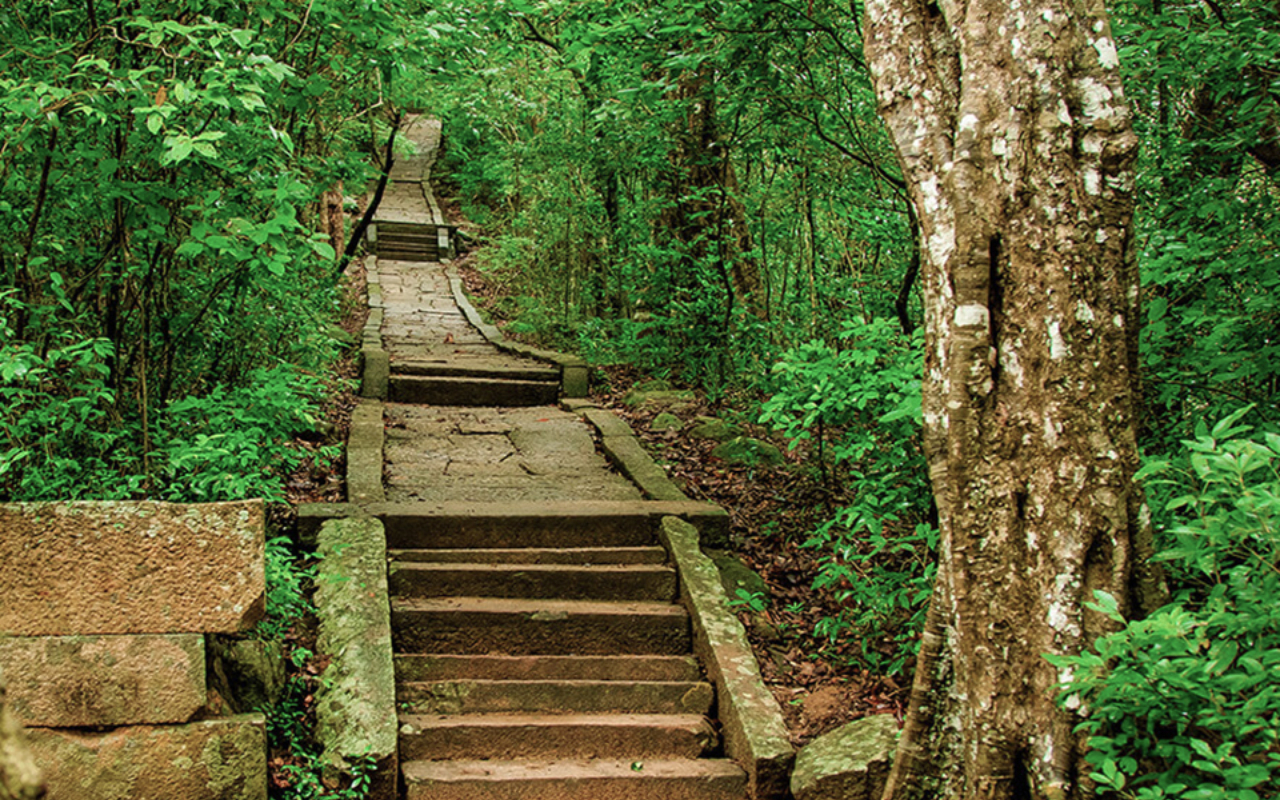Legend has it that this is the fragment of the Himalayas Hanuman dropped when carrying it to the battlefield in Lanka to find a medicinal herb to cure Laxmana in the Indian epic Ramayana. Others speak of how Prince Pandukabhaya battled his eight uncles at its foot with the help of Yakkas, who, to this day, are the mountain’s guardian spirits. Whatever legend or myth you believe, Ritigala is a place where stone and story intertwine. Rising like a forgotten sentinel shrouded in mist, mystery, and myth, this ancient mountain sanctuary, once home to ascetic monks, takes you into a sacred past precious to the island. Discover why you should make it a destination on your Cultural Triangle trip.
Where is Ritigala?
Ritigala lies between Anuradhapura and Polonnaruwa, two of Sri Lanka’s most ancient and sacred cities. It is in the northcentral province, the heartland of the Cultural Triangle, a region rich in history and culture with a high concentration of monuments and heritage sites. The site sits within the Ritigala Strict Nature Reserve, a protected forest covering the slopes of Ritigala Mountain, the highest peak in the north of Sri Lanka. It is on the popular Sigiriya and Dambulla circuit but far less visited as it remains a secret hidden in the jungle. Blue Lanka Tours makes it a mission to highlight these incredible spots that showcase unique beauty and interest.
History As We Know It
The recorded history of Ritigala goes back to the 3rd century BC when King Pandukabhaya sought refuge here. It was, chiefly, an ancient Buddhist monastery used by hermit monks called Pamsukulika, who practised extreme austerity. Rock inscriptions dating back to the 1st century BC stand testimony to this fact. The ruins you see today are from the monastery built by King Sena I in the 9th century AD.
The Monastic Complex
Located on the mountain’s east side, at the foot of a gorge, the monastic complex starts at a ritualistic bathing pond credited to King Pandukabhaya. The bathing area resembles a giant open-air theatre with rectangular stone seats. A wide stone path meanders up the forest, linking the monastery sections. Three large circular platforms found at intervals allow visitors to stop and rest. The site contains stone bridges, raised walkways, meditation platforms and intricately designed stone urinals and baths. The engineering is surprisingly advanced, with natural spring-fed pools and sophisticated drainage systems woven into the forested slopes.
Remnants of a monastery hospital still have grinding stones and huge stone-cut Ayurvedic oil baths. An artificial waterfall designed by placing a stone slab between two rocks showcases the richness of the wellness tradition. Except for a few broken granite Buddha statues in the caves, there are no typical Buddhist architectural elements here. You won’t find grand stupas or elaborate carvings. Instead, the ruins reflect an austere monastic lifestyle.
Flora, Fauna and Sacred Ecology
The wet microclimate of Ritigala is distinct from the region’s dry climate. Unlike the surrounding plains, the mountain summit receives significantly more rainfall and has a mist cover. It is lush, green and thick with rare medicinal plants, some of which are found nowhere else on the island. The evergreen foliage of tall trees provides cool shade to beat the sun. A sanctuary of silence, one can easily imagine why it was perfect for meditation. The peak is also the watershed of the Malwatu Oya, the second-longest river in Sri Lanka.
Wildlife includes deer, monkeys, wild boar and a variety of birds. However, because of the site’s protected status, visitors should stay on marked trails to avoid imposing themselves on unsuspecting creatures. Wild elephants, leopards and sloth bears inhabit the jungle beyond.
Connection to Ramayana
During the battle of Lanka, Rama’s younger brother, Laxmana, was gravely wounded. Hanuman, the trusty Monkey King, was tasked to bring the Sanjeevani herb, a powerful life-restoring plant, from the Himalayas. Unable to identify the exact herb, Hanuman lifted the entire chunk of the mountain and carried it back through the skies. As he flew over Sri Lanka, a piece of the mountain slipped from his grasp and fell to earth, forming Ritigala. This story attempts to explain why Ritigala, despite its location in the dry zone of Sri Lanka, is home to unusually lush vegetation and rare medicinal plants, some of which are not found anywhere else on the island.
Exploring the Realms where History, Nature and Legend Converge
Ritigala Monastery isn’t just another historical ruin – it’s a sacred landscape woven with legend, a hidden world of monks and myths carved into mossy jungle stone. Whether you’re a history buff, a nature lover, or a spiritual seeker, Ritigala offers an experience of deep reflection and wonder.
Blue Lanka Tours is passionate about taking you off the beaten path to places hidden in remarkable locations, lost to time, and enriched by local lore and uniqueness. As a travel company crafting responsible travel, we help you discover underrepresented destinations and attractions that take the heat off tourist hotspots. We also do our share to empower local communities in remote regions and safeguard natural ecosystems. Our travellers find authentic encounters, fewer crowds, and deeper connections with locals on their journeys. Discover more incredible locations like Ritigala in Sri Lanka with Blue Lanka Tours.
totoagung2
toto slot
slotgacor4d
totoagung
totoagung2
totoagung
amintoto
totoagung

